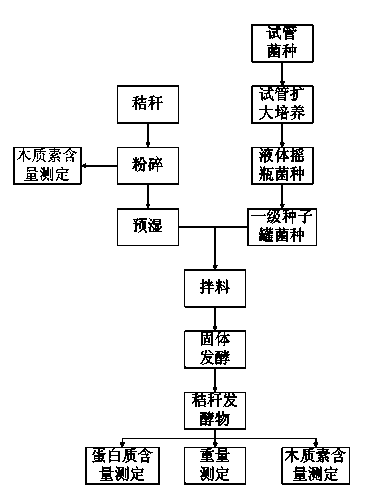Method for Aspergillus oryzae to degrade straw to produce protein feed
A protein feed, Aspergillus oryzae technology, applied in the field of bioengineering, can solve the problems of unsatisfactory treatment effect, large space occupation, long treatment time, etc.
- Summary
- Abstract
- Description
- Claims
- Application Information
AI Technical Summary
Problems solved by technology
Method used
Image
Examples
Embodiment 1
[0035] 1. Production of bacteria on test tube slant
[0036]Insert a ring of Aspergillus oryzae into the newly configured potato sucrose medium ("Industrial Microbiology Experimental Technology Manual" edited by Zhuge Jian and Wang Zhengxiang, 1994, page 367), at 26°C, and cultivate for 50 hours ; Store at 4°C for later use.
[0037] 2. Production of cultured strains in liquid shake flasks
[0038] Accurately weigh 5 grams of glucose, 0.1 grams of ammonium tartrate, 0.2 grams of benzyl alcohol, 0.2 grams of magnesium sulfate, 0.5 grams of Tween 80, 2 grams of potassium dihydrogen phosphate, 3 grams of phthalic acid buffer, 1000 mL of water, pH 5 , divided into 250mL triangular flasks, 50 grams per bottle, a total of 20 bottles, sterilized at 120 ° C for 40 minutes; after cooling, each bottle was inserted into a ring of Aspergillus oryzae strains preserved at 4 ° C, at 25 ° C, 150 rpm minutes, cultivated for 72 hours;
[0039] 3. Preparation of first-level liquid strains
...
Embodiment 2
[0046] 1. Production of bacteria on test tube slant
[0047] Insert a ring of Aspergillus oryzae into the newly configured potato sucrose medium ("Industrial Microbiology Experimental Technology Manual" edited by Zhuge Jian and Wang Zhengxiang, 1994, page 367), at 30°C, and cultivate for 100 hours ; Store at 7°C for later use.
[0048] 2. Production of cultured strains in liquid shake flasks
[0049] Accurately weigh 150 grams of glucose, 250 grams of ammonium tartrate, 15 grams of benzyl alcohol, 0.4 grams of magnesium sulfate, 4 grams of Tween 80, 5 grams of potassium dihydrogen phosphate, 20 grams of phthalic acid buffer, 10 L of water, pH 6, Divide into 250mL triangular flasks, 100 grams per bottle, 100 bottles in total, sterilize at 130°C for 30 minutes; after cooling, put a ring of Aspergillus oryzae strains stored at 7°C in each bottle, at 30°C, 150 rpm , cultivated for 50 hours;
[0050] 3. Preparation of first-level liquid strains
[0051] Accurately weigh 2000 gr...
Embodiment 3
[0057] 1. Production of bacteria on test tube slant
[0058] Insert a ring of Aspergillus oryzae into the newly configured potato sucrose medium ("Industrial Microbiology Experimental Technology Manual" edited by Zhuge Jian and Wang Zhengxiang, 1994, page 367), at 35°C, and cultivate for 144 hours ; Store at 10°C for later use.
[0059] 2. Production of cultured strains in liquid shake flasks
[0060] Accurately weigh 300 grams of glucose, 50 grams of ammonium tartrate, 30 grams of benzyl alcohol, 10 grams of magnesium sulfate, 100 grams of Tween 80, 90 grams of potassium dihydrogen phosphate, 180 grams of phthalic acid buffer, 10 L of water, pH7.5 , divided into 250mL triangular flasks, 120 mL per bottle, 80 bottles in total, sterilized at 140°C for 20 minutes; minutes, cultivated for 72 hours;
[0061] 3. Preparation of first-level liquid strains
[0062] Accurately weigh 1,500 grams of glucose, 250 grams of ammonium tartrate, 150 grams of benzyl alcohol, 50 grams of mag...
PUM
 Login to View More
Login to View More Abstract
Description
Claims
Application Information
 Login to View More
Login to View More - R&D
- Intellectual Property
- Life Sciences
- Materials
- Tech Scout
- Unparalleled Data Quality
- Higher Quality Content
- 60% Fewer Hallucinations
Browse by: Latest US Patents, China's latest patents, Technical Efficacy Thesaurus, Application Domain, Technology Topic, Popular Technical Reports.
© 2025 PatSnap. All rights reserved.Legal|Privacy policy|Modern Slavery Act Transparency Statement|Sitemap|About US| Contact US: help@patsnap.com



